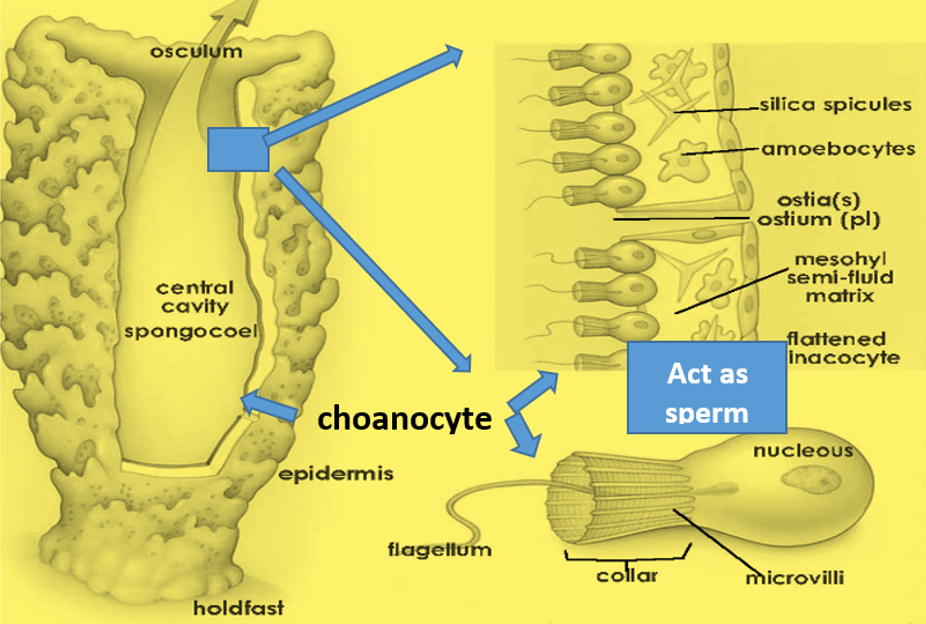Which were the first animals to have sperm? Have basic sperm components changed much over the course of evolution?
So, where do sperm come from an evolutionary perspective?

Fig. 1: A figurative display of sperm.
Let is start from the very beginning. In the simplest animals such as Protozoa (mainly single cell animals such as Paramecium) sexual reproduction involves meiosis of micro nuclei in the cytoplasm followed by cell membrane fusion of two or more Paramecia and then exchange of these haploid micro nuclei (containing half the DNA). This fusion of the haploid micro nuclei will assemble the diploid state and is referred to as conjugation. Although this is clearly a means of sexual reproduction none of these haploid micro nuclei has any relationship to sperm or oocytes.
May be the simplest multicellular animals provide a clue to where sperm come from? Living Coelenterates (sponges, sea anemones, jellyfish, Fig 2) are the first truly multicellular animals consisting of at least an outside (ectoderm) and inside layer of cells (endoderm) with a cavity, the spongocoel in between. Their cellular organization is extremely simple with only a few differentiated cells such as amebocytes, choanocytes (Fig. 3).
Choanocytes (“collar cells”) (Fig. 3) are present at various locations, depending on the type of coelenterate; they line the inner portions of the space through which water flows: the spongocoel in simple coelenterates such as sponges. Choanocytes have multiple functions and their primary function is to generate a water current through the sponge to trap and ingest food particles by phagocytosis. Choanocytes also function as sperm cells. In Fig. 3 it is clear that they possess the basic sperm features of a nucleus (sperm head) and tail (flagellum). This appears to be the very first sperm in the animal kingdom.

Fig. 2: From left to right: Sea anemone, sponge and jellyfish.
The second crucial cells in sponges are called amoebocytes (or archeocytes). Amoebocytes have a variety of functions: delivering nutrients from choanocytes to other cells within the sponge; giving rise to eggs for sexual reproduction; delivering phagocytized sperm from choanocytes to eggs; and differentiating into more-specific cell types. Accordingly, for the first time in the Animal Kingdom male and female gametes are clearly differentiated.

Fig. 3: Typical design of a simple coelenterate and showing the structure of the choanocyte containing the basic sperm components (Greatly Modified from choanocytes in sponges – Bing images).
According to a study, a gene called BOULE is responsible for sperm production and is found in almost all animals, ranging from invertebrates to mammals. The gene is so vital that its function has remained unaltered throughout evolution and is the only gene known to be exclusively required for sperm production in animals.
The presence of this gene in sea anemones (emphasizing very primitive life-forms) suggests that the ability to produce sperm evolved only once, roughly 600 million years ago. Although the gene’s function is highly conserved among animals, it has diverged to produce many different forms.
What is the evidence favoring the 600 million years’ origin of sperm? Half a billion years ago, an unusual-looking animal crawled over the sea floor, using tentacles to pick up food particles along the way (possibly a coelenterate or similar). Known as Rotadiscus grandis, this animal lived during the Cambrian period when a burst of evolutionary activity is thought to have given rise to many of the major animal groups we see today.
It furthermore seems that the basic sperm features of head, midpiece and tail have been well preserved over more than 500 million years. Animal sperm from presumably annelids, segmented worms (presumably earthworms or leeches), have been found in fossils 50 million years old. This is still young compared to plant sperm found in fossilized plants in Scotland some 400 million years ago.

Fig. 4: Rare example of fossilized sperm found in animals such as earthworms or leeches 50 million years ago showing the sperm head (H), midpiece (MP) and flagellum (F). The white scale bar is 1µm. Modified after Dept Palaeobiol. / Swedish Museum of Natural History.
Renee Pera from Stanford suggests that the BOULE gene and its derivatives have contributed to the specificity of sperm while maintaining the conserved function throughout.
Accordingly, the basic sperm components have been conserved from an evolutionary point of view since the first sperm appeared, but major morphological adaptations have taken place related to the fertilization environment and sperm competition among others. For example, sperm of broadcast spawners such as sea urchins and many fish are very simple with a conical to spherical sperm head, 4 to 5 mitochondria in the midpiece and a simple tail with an axoneme showing the 9 + 2 pattern of microtubules. In contrast sperm of internal fertilizers have developed many additional structures such as extra protein sheaths (strengthening sperm swimming in a viscous environment) outside the 9+2 axoneme, and as many as 300 mitochondria. In some crustaceans the sperm has no flagellum and the adaptation relate to the eggs being transported to the sperm inside the female reproductive system. It furthermore seems that sperm functional traits have also been conserved over millions of years; for example, the Catsperm genes responsible for hyperactivation can be found in almost all animal groups.
Prof Gerhard van der Horst (PhD, PhD)
Senior Consultant
MICROPTIC S.L. (A Hamilton Thorne Company)



Leave A Comment